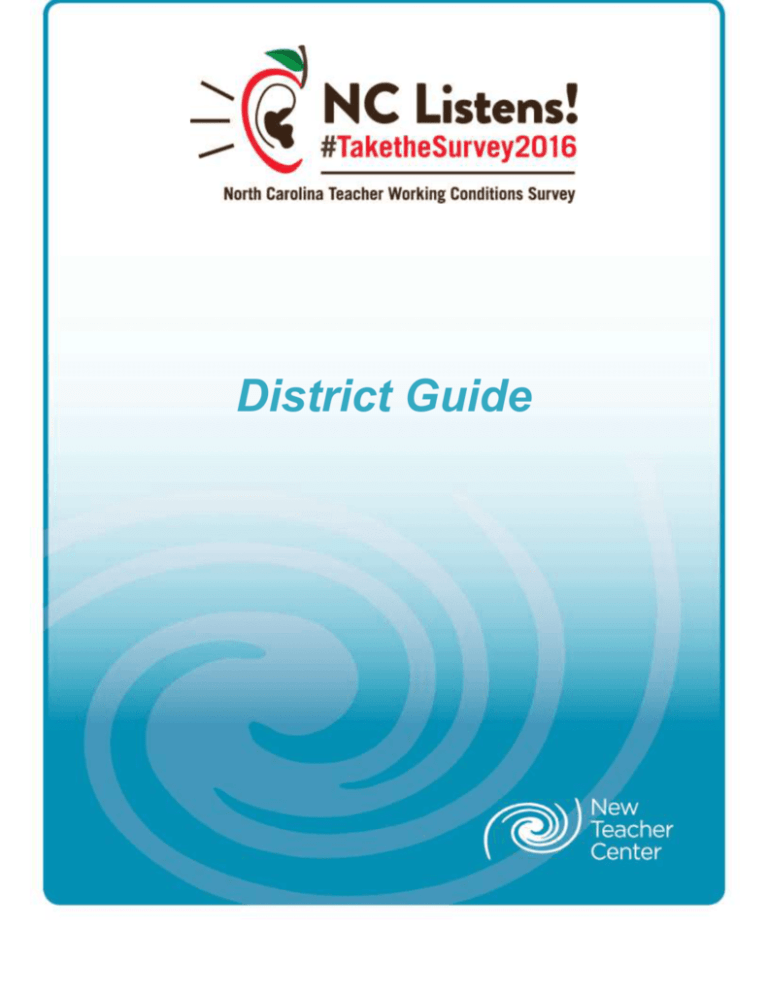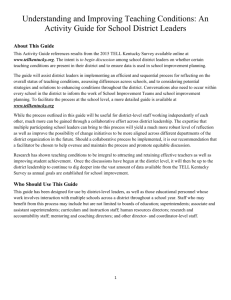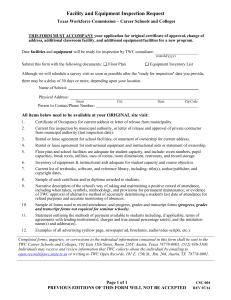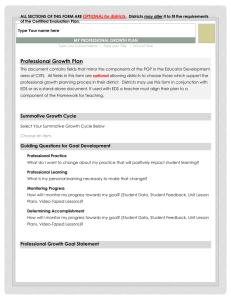An Activity Guide for School District Leaders
advertisement

District Guide 1 Understanding and Improving Teaching Conditions: An Activity Guide for School District Leaders About This Guide This Activity Guide references results from the 2016 North Carolina Teacher Working Conditions Survey (NC TWC)available online at www.ncteachingconditions.org. The intent is to begin discussion among school district leaders on whether certain working conditions are present in their district and to ensure data is used in school improvement planning. The guide will assist district leaders in implementing an efficient and sequential process for reflecting on the overall status of working conditions, assessing differences across schools, and to considering potential strategies and solutions to enhancing conditions throughout the district. Conversations also need to occur within every school in the district to inform the work of School Improvement Teams and school improvement planning. To facilitate the process at the school level, a more detailed guide is available at www.ncteachingconditions.org. While the process outlined in this guide will be useful for district-level staff working independently of each other, much more can be gained through a collaborative effort across district leadership. The expertise that multiple participating school leaders can bring to this process will yield a much more robust level of reflection as well as improve the possibility of change initiatives to be more aligned across different departments of the district organization in the future. Should a collaborative process be implemented, it is our recommendation that a facilitator be chosen to help oversee and maintain the process and promote equitable discussion. Research has shown working conditions to be integral to attracting and retaining effective teachers as well as improving student achievement. Once the discussions have begun at the district level, it will then be up to the district leadership to continue to dig deeper into the vast amount of data available from the NC TWC Survey as annual goals are established for school improvement. Who Should Use This Guide This guide has been designed for use by district-level leaders, as well as those educational personnel whose work involves interaction with multiple schools across a district throughout a school year. Staff who may benefit from this process may include but are not limited to boards of education; superintendents; associate and assistant superintendents; curriculum and instruction staff; human resources directors; research and accountability staff; mentoring and coaching directors; and other director- and coordinator-level staff. 2 Activity I: Thinking Globally – A District-Level Comparison To participate in this activity, please access the results of the 2016 NC TWC Survey online at www.ncteachingconditions.org. The table on the next page contains one question from each of the eight different constructs of the NC TWC Survey which best represent the findings in that overall construct. Analyses conducted over previous iterations of the survey indicate that teacher response rates to these particular questions can be a good starting point in discussions. They tend to be predictive of teacher response rates in other questions with the construct. In this exercise, you will compare your district’s survey results on these eight questions to the state average and one or two other districts of your choice. The purpose of this comparison with other districts is not for accountability purposes, but to help give better context and bring better understanding to your interpretation of your data results. As you reflect on which districts to include in your comparison process, you may want to consider districts that are similar in size, serve similar communities, are in close proximity with each other, or serve similar student populations. 1. To the right of the cell that reads ‘Insert District Names Here,’ place the name of your district and the one or two other districts you are interested in comparing your results within this exercise. 2. To access results from the website, click the button labeled “Survey Results” at the top of the main page. 3. Locate your district’s name in the list and click on the summary results icon to the right of the name. 4. Find the percent agreement, educators who responded either ‘agree’ or ‘strongly agree’, to the questions listed in the table under the ‘district’ column and write them in the corresponding boxes in the table. This view should also provide you the state level results which can be written into the state column boxes. 5. Repeat steps 2, 3 and 4 for the other districts you are interested in comparing and place their percent agree results in their corresponding boxes. The Eight Working Conditions Constructs Time—Available time to plan, collaborate and provide instruction and eliminating barriers to maximize instructional time during the school day. Facilities and Resources—Availability of in instructional, technology, office, communication, and school resources to teachers. Community Support and Involvement— Community and parent/guardian communication and influence in the school. Managing Student Conduct—Policies and practices to address student conduct issues and ensure a safe school environment. Teacher Leadership—Teacher involvement in decisions that impact classroom and school practices. School Leadership—The ability of school leadership to create trusting, supportive environments and address teacher concerns. Professional Development—Availability and quality of learning opportunities for educators to enhance their teaching. Instructional Practices and Support— Data and support available to teachers to improve instruction and student learning. 3 Activity I: District Level Comparison Survey Questions (One question from each of the eight different constructs of the NC TWC Survey which strongly represent the findings in that overall construct.) Percent Agreement* Your District LEA of Interest LEA of Interest State NC Insert District Names Here TIME: The non-instructional time provided for teachers in my school is sufficient. FACILITIES AND RESOURCES: Teachers have sufficient access to appropriate instructional materials. COMMUNITY SUPPORT AND INVOLVEMENT: Parents/guardians are influential decision makers in this school. MANAGING STUDENT CONDUCT: School administrators consistently enforce rules for student conduct. TEACHER LEADERSHIP: The faculty has an effective process for making group decisions to solve problems. SCHOOL LEADERSHIP: There is an atmosphere of trust and mutual respect in this school. PROFESSIONAL DEVELOPMENT: Professional development enhances teachers' abilities to improve student learning. INSTRUCTIONAL PRACTICES AND SUPPORT: Provided supports (i.e. instructional coaching, professional learning communities, etc.) translate to improvements in instructional practices by teachers. *The percentage of educators who responded either ‘agree’ or ‘strongly agree’ to these questions 4 Activity I: District Level Comparison Reflection Prompts Compare your district results to the state. In which constructs is your district above the state average? What policies or supports systems exist in your district that may be contributing to being above the state average in each construct? In which constructs is your district below the state average? What might be some explanations that would account for your district being lower than the state average in these constructs? Before you begin comparing your district results to the two districts you selected for comparison, discuss the reasons you selected these two districts as being relevant to your district. Compare your district results to each LEA of interest: In which constructs were your results similar? In which areas were they different? What policies, practices and supports are in place in your district that may explain disparities (i.e. additional resources from grants, corporate partners, amount of community involvement and support, recent focus on targeted professional development, etc.) What are some of the differences in the demographics of students and teachers between your district and the comparison districts you selected? 5 Activity II: Reflections On Schools In Your District Reflecting on the different schools in your district, choose three schools based on the following criteria: 1. Choose one school that you anticipate will have the most positive working conditions relative to other schools in the district (High WC). 2. Choose one school that you anticipate will have similar working conditions relative to other schools in the district (Average WC). 3. Choose one school that you predict will have less positive working conditions relative to other schools in the district (Low WC). Place the names of those schools on the following page in the boxes provided at the top of the page. In the next section of the worksheet, brainstorm one of the eight constructs provided and where you think large differences in the factors/events/elements are in place between the three schools being examined. To do this, think first about the differences between the ‘high’ working conditions school and the ‘low’ working conditions school before reflecting on the school in middle which may make the process easier. 1. Place the number of the construct you select in the construct box of the first table. 2. In the space provided, try and explain as best you can what some of the differences are between the three schools you have selected. 3. Repeat the process in the next two tables choosing a different construct for each. The following example may help to guide your work: School With High WC School With Average WC School With Low WC Smith Elementary Central High Hampton Elementary 1. 2. 3. 4. Construct Constructs Time 5. Teacher Leadership Facilities and Resources 6. School Leadership Community Support and Involvement 7. Professional Development Managing Student Conduct 8. Instructional Practices and Support School High 5. Instructional Practices and Support Average Low Differences Strong leader who involves teachers in decision making, school schedules planned to encourage collaboration amongst staff, veteran teachers, healthy school culture, teachers actively collaborate to address students’ needs, stable workforce, equity in classrooms Mostly sound instructional practices, support needed mostly in language arts, some collaboration in math and science, limited differentiation, poor support of English second language learners High teacher turnover rate with a lot of inexperienced teachers on staff, limited teacher leadership and little collaboration, teachers don’t know what to do, lots of district support needed and received, high numbers of ELL students and limited support for their needs; school schedule not prioritized to assist teachers 6 Activity II continued School With High WC 1. 2. 3. 4. Construct School With Average WC School With Low WC Constructs Time 5. Teacher Leadership Facilities and Resources 6. School Leadership Community Support and Involvement 7. Professional Development Managing Student Conduct 8. Instructional Practices and Support School Differences High Average Low Construct School Differences High Average Low Construct School Differences High Average Low 7 Activity III: Thinking Locally – A Deeper Examination of Your District Data To participate in this activity, please access the results of the 2016 NC TWC Survey online at www.ncteachingconditions.org. In this exercise, you will be examining the same construct questions from Activity I. However, instead of reflecting on the district level, this exercise will examine individual school results within your district of the schools you identified in Activity II. The table on the next page is organized in the same manner as the first activity. 1. To the right of the cell that reads ‘Insert School Names Here,’ place the name of the school in your district that you anticipated in Activity II that would exhibit very high working conditions relative to other schools in your district in the column labeled ‘High’. Place the name of the school in your district that you predicted would exhibit average working conditions relative to other schools in your district in the column labeled ‘Average’. Finally, place the name of the school in your district that you anticipated would exhibit low working conditions relative to other schools in your district in the column labeled ‘Low’. 2. Using the same process you applied in Activity I, look up each individual school’s summary results on the survey website and place the percent agreement rates in the corresponding boxes of the table. 3. In the final column, labeled ‘Difference Between High and Low’ subtract the percent agreement from the high school by the percent agreement score of the low school for each of the questions in the table and place the results into the corresponding boxes. 8 Activity III: School Level Comparison Survey Questions Percent Agreement* (One question from each of the eight different constructs of the NC Working Conditions Survey which best represent the findings in that overall construct.) High Average Low Insert School Names Here TIME: The non-instructional time provided for teachers in my school is sufficient. FACILITIES AND RESOURCES: Teachers have sufficient access to appropriate instructional materials. COMMUNITY SUPPORT AND INVOLVEMENT: Parents/guardians are influential decision makers in this school. MANAGING STUDENT CONDUCT: School administrators consistently enforce rules for student conduct. TEACHER LEADERSHIP: The faculty has an effective process for making group decisions to solve problems. SCHOOL LEADERSHIP: There is an atmosphere of trust and mutual respect in this school. PROFESSIONAL DEVELOPMENT: Professional development enhances teachers' abilities to improve student learning. INSTRUCTIONAL PRACTICES AND SUPPORT: Provided supports (i.e. instructional coaching, professional learning communities, etc.) translate to improvements in instructional practices by teachers. *The percentage of educators who responded either ‘agree’ or ‘strongly agree’ to these questions. 9 Difference Between High and Low Activity III: School Level Comparison Reflection Prompts Are there constructs where there are meaningful differences between the three schools? Are the responses reflective of your perceptions of the teaching conditions within each of the schools? Are there constructs where there is very little difference between the three schools? Are these smaller differences specific to the construct or is one school more/less positive than you anticipated? Why? Are there any constructs where a school you thought had less positive conditions outperformed a school you perceived had more positive conditions (or a school you anticipated had the best teaching conditions had fewer educators responding positively)? Why? What might be going on within the school for which you did not account? Why might the faculty be more or less inclined to indicate that there are positive conditions on the survey? How do the results of Activity III compare to your anticipation of these schools’ results in Activity II? Are there large differences between your perceptions and the data? If so, where and how does this inform your work? Are there some similarities between your predictions and the findings, and how does that inform your work? (If there was little difference between the high and low schools across the entire exercise, consider choosing different schools and repeating the exercise.) Any additional thoughts: 10 Activity IV: Determining Reasons for School Level Differences Which Can Be Addressed at the District Level So far you have compared your district’s working conditions results with other similar districts to give you contextual data on a holistic level. You have also reflected on differences between schools with high working conditions and low working conditions relative to schools across the your district to consider a more atomistic level. In this exercise, you will consider four different components of your district and how they may be affecting your working conditions in the schools you examined for Activity III. Students Teachers Leadership Community COMMUNITY: Compare the communities in each of the schools you identified in Activity III. What roles do parents/guardians and other members of the community play within the participating schools? What activities do they support (instructional vs. non-instructional, etc.) and what decisions do they influence? Does the School Improvement Team function well in each school? Which member from the community is represented on the School Improvement Team? How active and engaged is the PTA? Does PTA participation reflect the demographics of the school population? What are some challenges to engaging parents/guardians? Are there any businesses or foundations engaged with these schools? 11 Activity IV continued LEADERSHIP: Compare the leadership in each of the schools you identified in Activity III. How experienced is the leadership at each school? What type of training has each leader received in the past 2 years? What leadership style does each school administrator exhibit? What evidence shows the leadership encourages teachers to work collaboratively when given time to do so? How well do school administrators function in a collaborative setting? TEACHERS: Compare the teaching population in each of the schools you identified in Activity III. What are teachers’ average years of experience? How many National Board certified teachers are there? 12 How many teachers are teaching classes and students for which they are not best suited? See answers to question 9.1h on the 2016 NCTWC Survey. Do the teachers in the school work well together to meet the needs of their students? STUDENTS -Think about how the students attending each of the schools identified in Activity III are similar and different. How does the socio-economic status of students served vary across the three schools? Are students coming to school ready to learn? What support (professional development, coaching, etc.), personnel (social workers, guidance counselors, etc.) and/or services are in place to help all learners receive a high quality education? FOR FURTHER THOUGHT - If time, you may also want to further define schools in your district so that you can highlight the schools of similar demographics (% Free and Reduced Lunch, Urbanicity) and identify schools of like demographics that can be highlighted and share their best practices. For example, select two schools of similar grade level, demographics in your district but have the least favorable working conditions on the NC TWC Survey and compare to a school that has most favorable working conditions. 13 Activity V: District Level Support for Site Administrators One of the many benefits of the NC TWC Survey is that the data can inform district leaders as to ways the supports they put in place for site administrators are perceived. As your district begins discussions around the NC TWC data, it will be important to reflect on the following questions about district-level supports for school level leadership. In your reflection of the following prompts, consider what systems and supports are currently in place in your district to meet these needs and place that information in the corresponding box. In the other box provided, write down the ideal systems and structures needed to support district needs. Responses to questions on the survey may help you assess perceptions of policies. Districts can request a report of answers from principals to questions about district supports if a sufficient number of principals participated by contacting the North Carolina Department of What is currently in place in What is the ideal for your Education. your district? district? Professional development for principals to enhance their instructional leadership skills and create positive teaching conditions Induction for principals new to school leadership and/or new to the district Process for identifying issues and practices across schools to improve teaching conditions Process for engaging parents/ guardians and the community in school activities and improvement planning Policies and practices specific to engaging teachers in decision making within schools 14 Activity V continued What is currently in place in your district? What would be ideal for your district? Assessment of the functioning of School Improvement Teams across schools Guidance and assistance to SITs in understanding and addressing teaching conditions issues Identifying and highlighting schools with best practices of positive teaching conditions Reflection Prompts for Activity V. Are the support systems currently in place the same as the ideal? If not, why might they be different? Does it vary by school, and if so, how and why? What resources will it take to make the “ideal” a reality? 15 Activity VI: NEXT STEPS - Continuous Improvement for School Success This Guide is intended to begin discussion among school district leaders on just a few of the many ways the data from the 2016 NC TWC Survey can be helpful in decisions about school improvement. Over the next two years it will be important for your district to continue focusing on ways this data can be helpful in other areas such as staffing for hard-to-staff schools, teacher and principal retention, professional development, facilities and resources, and student conduct. This exercise seeks to take one of the systems identified in Activity V and develop a basic plan of action to improve it. Below, an organizational chart has been built to help guide your reflections and decision-making process. 16 Activity VI: NEXT STEPS – Continuous Improvement for School Success Place one of the ‘What Would Be Ideal’ Items from Activity V in this box. Identify steps that need to happen to achieve the ‘Ideal’ in your district. Who/what departments need to be engaged to address this step? Who is responsible for overseeing this step? What is an appropriate timeline? 17









